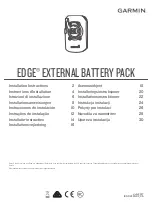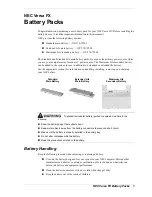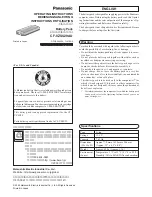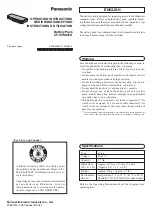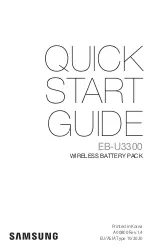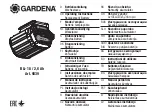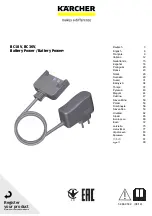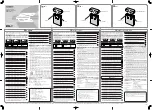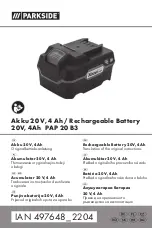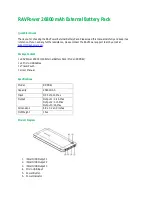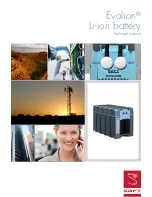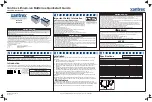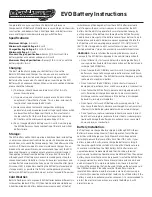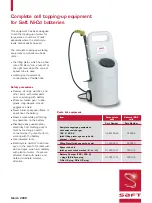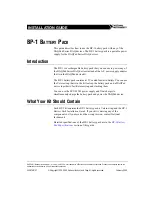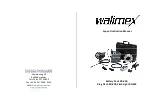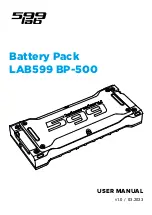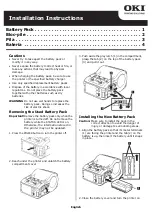
4
1.1.2. Description of
STM MR-MRE nickel-cadmium
monoblocks
The low maintenance STM
monoblock consists of 5 nickel-
cadmium cells of 1.2 V nominal
voltage each.
These 5 cells are assembled into
a polypropylene monoblock
container to obtain a nominal
voltage of 6 V.
The suffix MR indicates low
maintenance and air cooling.
The suffix MRE indicates low
maintenance and water cooling.
When the monoblocks are
delivered in single monoblock
units (not pre-assembled by Saft
into crates or boxes), the
monoblock STM 5-140 MR is
supplied with belt plates. In order
to decrease the weight of each
battery unit during use, the belt
plates of STM 5-140 monoblocks
can be removed if the battery
structure (crates or boxes, etc.)
provides sufficient mechanical
protection against deformation of
the small sides of the monoblocks
(refer to chapter 3.).
The monoblock STM 5-100 MR
and MRE’s do not have
independent support plates.
The support structure is integrated
in the monoblock container.
The blocks will be assembled
into a battery by serial
interconnection, in order to
achieve the desired operational
voltage. When the forced air
cooling monoblocks are mounted
into a vehicle, sufficient space
along the large sides must be
provided for correct cooling.
!
Electrodes
The STM monoblocks are
constituted of sintered positive
electrodes and plastic bonded
negative electrodes.
The positive electrode is created
by chemical impregnation of
nickel hydroxide and additives
into a sintered nickel structure,
placed onto a perforated nickel-
plated steel strip.
The negative electrode is
obtained by pasting cadmium
oxide and a plastic bonding
additive onto a perforated
nickel-plated steel strip.
Subsequently, a multi-layer
separator is placed between the
positive and the negative
electrodes to form the plate-group.
!
Electrolyte
The alkaline electrolyte in a nickel-
cadmium battery is a liquid
solution of potassium hydroxide
(KOH), lithium hydroxide (LiOH),
or sodium hydroxide (NaOH) into
distilled or demineralized water.
During the electrochemical
reactions, the physical density of
the electrolyte remains practically
constant. Under no circumstances
can it be used as an indicator of
state of charge.
Only overcharging will cause a
normal water consumption and a
slow concentration in the physical
density of the electrolyte.
The difference in density between
a charged and a discharged
battery can be considered to be
negligeable.
After topping-up of the battery,
the density of the electrolyte is at
its lowest. After consumption of
the electrolyte reserve, the density
of the electrolyte is at its highest.
The construction of a monoblock
does not permit electrolyte
sampling of an STM battery
with integrated ramp without
mechanical destruction of the
monoblock. Measuring the density
of the electrolyte is therefore
impossible.
!
Separator
The separator of the STM
monoblocks is multilayer, non-
woven and made of
polypropylene. It was selected
to satisfy the three principal
objectives: to be a good insulator
between the electrodes, to have
the right porosity for excellent
electric performance during
charge and discharge, and
ensure the passage of oxygen
ions during charge to facilitate
he recombination.
!
Container
The monoblock container and
the fluid chambers containing
the cooling liquid, if present, are
made of polypropylene, as are
the cover and the filling ramp
that are welded to the container
after the insertion and connection
of the battery plate-group and
the electrolyte.
Summary of Contents for STM 5-100
Page 1: ...Technical manual installation operation and maintenance for Ni Cd STM MR MRE monoblocks type ...
Page 23: ...Appendix 1 20 Monoblock STM 5 100 MR G RD equipped Positive left Filling right ...
Page 24: ...21 Appendix 2 Monoblock STM 5 100 MRE G RD equipped Positive left Filling right ...
Page 25: ...Appendix 3 22 Monoblock STM 5 140 MR G RD equipped Positive left Filling right ...
Page 26: ...Appendix 4 23 Monoblock STM 5 140 MR D RG equipped Positive right Filling left ...























